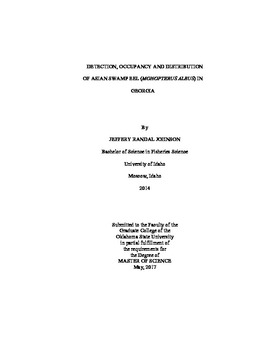| dc.contributor.advisor | Long, James M. | |
| dc.contributor.author | Johnson, Jeffery Randal | |
| dc.date.accessioned | 2018-06-13T16:19:36Z | |
| dc.date.available | 2018-06-13T16:19:36Z | |
| dc.date.issued | 2017-05-01 | |
| dc.identifier.uri | https://hdl.handle.net/11244/300029 | |
| dc.description.abstract | More than 100 species of exotic freshwater fishes have been introduced into the United States, threatening native species and causing an estimated economic impact of $1 billion annually. Currently, there are 4 known populations of Asian Swamp Eel (Monopterus albus) introduced into the continental U.S. The first population of Asian Swamp Eel was discovered in three ponds at a private nature facility in Northern Georgia in 1994. Research activity on this population has been limited due to challenging sampling conditions and characteristics that make Asian Swamp Eels difficult to capture. To account for this, we implemented an occupancy modeling approach with multiple sampling methods to garner information about detection, occupancy and distribution of this Asian Swamp Eel population. Leaf litter traps were used in the Chattahoochee River and backwater marsh areas within a 2-km radius of the presumed invasion point to estimate detection, and delineate the current invasion extent. Covariates likely to explain Asian Swamp Eel presence were used to model probabilities of occupancy from leaf litter trap sampling. The top model of detection probability included year, and temperature and depth at the time of sampling. Detection probability increased with sampling depth and temperature. The top model of occupancy included proportion of area vegetated and proportion of area silt substrate, and occupancy was positively associated with both. A distribution map was created by interpolating covariates for unsampled areas, and estimates of occupancy probability were backtransformed for the entire study area. Asian Swamp Eel distribution appears limited within the Chattahoochee River, and backwater marsh areas in the immediate vicinity of the presumed invasion point have the highest probabilities of occupancy. Adult Asian Swamp Eels were sampled within two ponds and the backwater marsh areas with canoe-based backpack electrofishing. Occupancy was unable to be modeled for adult Asian Swamp Eels, but detection was able to be estimated for the two ponds. Probable differences in detection along with persistence time indicate that there may be a more substantial marsh population than previously thought. | |
| dc.format | application/pdf | |
| dc.language | en_US | |
| dc.rights | Copyright is held by the author who has granted the Oklahoma State University Library the non-exclusive right to share this material in its institutional repository. Contact Digital Library Services at lib-dls@okstate.edu or 405-744-9161 for the permission policy on the use, reproduction or distribution of this material. | |
| dc.title | Detection, Occupancy and Distribution of Asian Swamp Eel (Monopterus albus) in Georgia | |
| dc.contributor.committeeMember | Papes, Monica | |
| dc.contributor.committeeMember | Phelps, Quinton | |
| osu.filename | Johnson_okstate_0664M_15141.pdf | |
| osu.accesstype | Open Access | |
| dc.description.department | Natural Resources and Ecology Management | |
| dc.type.genre | Thesis | |
| dc.type.material | text | |
